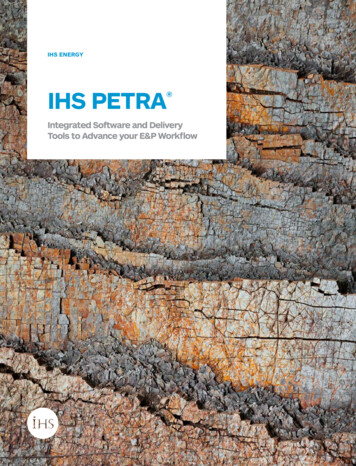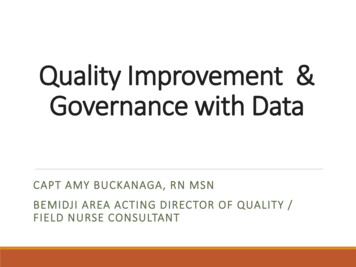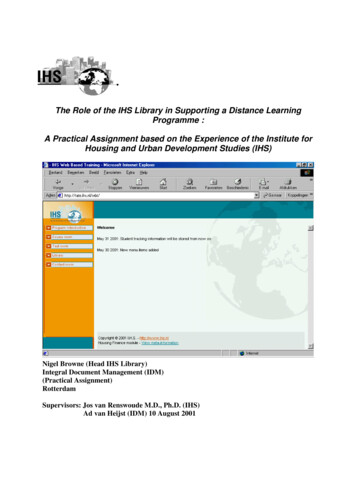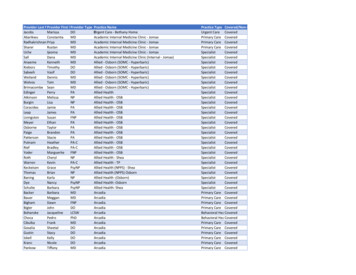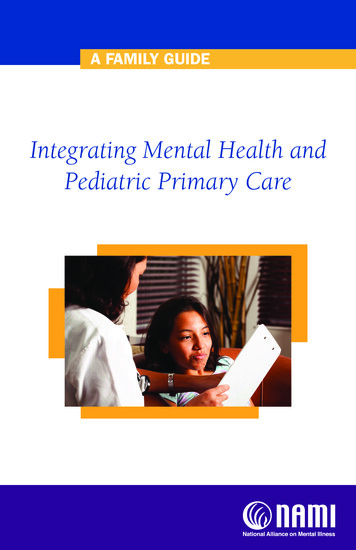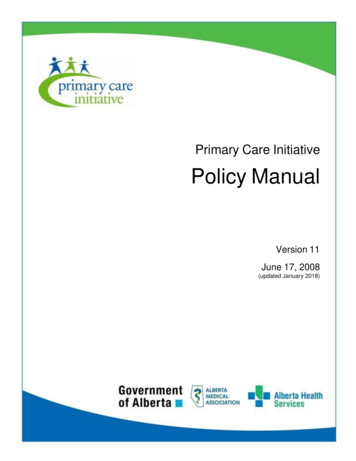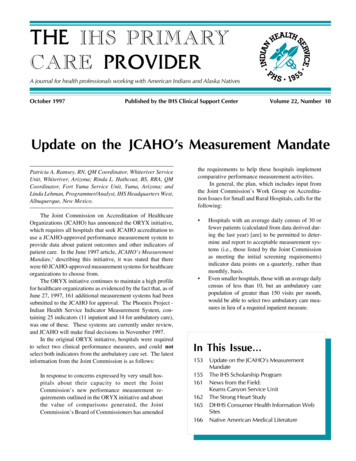
Transcription
THE IHS PRIMARYCARE PROVIDERA journal for health professionals working with American Indians and Alaska NativesOctober 1997Published by the IHS Clinical Support CenterVolume 22, Number 10Update on the JCAHO s Measurement MandatePatricia A. Ramsey, RN, QM Coordinator, Whiteriver ServiceUnit, Whiteriver, Arizona; Rinda L. Hathcoat, BS, RRA, QMCoordinator, Fort Yuma Service Unit, Yuma, Arizona; andLinda Lehman, Programmer/Analyst, IHS Headquarters West,Albuquerque, New Mexico.The Joint Commission on Accreditation of HealthcareOrganizations (JCAHO) has announced the ORYX initiative,which requires all hospitals that seek JCAHO accreditation touse a JCAHO-approved performance measurement system toprovide data about patient outcomes and other indicators ofpatient care. In the June 1997 article, JCAHO’s MeasurementMandate,1 describing this initiative, it was stated that therewere 60 JCAHO-approved measurement systems for healthcareorganizations to choose from.The ORYX initiative continues to maintain a high profilefor healthcare organizations as evidenced by the fact that, as ofJune 27, 1997, 161 additional measurement systems had beensubmitted to the JCAHO for approval. The Phoenix Project Indian Health Service Indicator Measurement System, con taining 25 indicators (11 inpatient and 14 for ambulatory care),was one of these. These systems are currently under review,and JCAHO will make final decisions in November 1997.In the original ORYX initiative, hospitals were requiredto select two clinical performance measures, and could notselect both indicators from the ambulatory care set. The latestinformation from the Joint Commission is as follows:In response to concerns expressed by very small hos pitals about their capacity to meet the JointCommission’s new performance measurement re quirements outlined in the ORYX initiative and aboutthe value of comparisons generated, the JointCommission’s Board of Commissioners has amendedthe requirements to help these hospitals implementcomparative performance measurement activities.In general, the plan, which includes input fromthe Joint Commission’s Work Group on Accredita tion Issues for Small and Rural Hospitals, calls for thefollowing: Hospitals with an average daily census of 30 orfewer patients (calculated from data derived dur ing the last year) [are] to be permitted to deter mine and report to acceptable measurement sys tems (i.e., those listed by the Joint Commissionas meeting the initial screening requirements)indicator data points on a quarterly, rather thanmonthly, basis.Even smaller hospitals, those with an average dailycensus of less than 10, but an ambulatory carepopulation of greater than 150 visits per month,would be able to select two ambulatory care mea sures in lieu of a required inpatient measure.In This Issue153155161162165166Update on the JCAHO s MeasurementMandateThe IHS Scholarship ProgramNews from the Field:Keams Canyon Service UnitThe Strong Heart StudyDHHS Consumer Health Information WebSitesNative American Medical LiteratureOctober 1997 o THE IHS PROVIDER153
Hospitals with an average daily census of lessthan 10 and an ambulatory care population ofless than 150 would be temporarily excused fromthe ORYX requirements.Finally, proposed incremental measurement re quirements over time will be adjusted for verysmall hospitals to the extent necessary to main tain statistically valid data point determinationson a quarterly basis.Potentially affected hospitals will be noti fied of these revised requirements through a let ter in the near future.The Joint Commission has indicated that laboratories andambulatory care facilities will be required to select an indica tor measurement system by the end of 1998. Additionalindicators meeting laboratory requirements will be added tothe Phoenix Project - Indian Health Service Indictor Measure ment System and submitted to JCAHO for approval in the nextyear. New indicators will be added to the system annually.If the Phoenix Project - Indian Health Service IndicatorMeasurement System is approved by the JCAHO, it will be154THE IHS PROVIDER o October 1997available throughout the Indian health system. Use of thePhoenix Project system instead of any of the others approvedby the Joint Commission can save participating Indian healthfacilities a subscription fee of 5,000 to 11,000 annually. Inaddition, Indian health facilities will be spared the expense andinconvenience of hiring additional full time employees toperform duplicate data entry into another vendor’s software.A program will be designed for training appropriate per sonnel about using the Phoenix Project - Indian Health ServiceIndicator Measurement System. As a result of this training,we anticipate improved documentation on PCC and inpatientrecords providing complete, quality data on the patient’s medi cal record; enhanced accuracy and timeliness of data entry,thereby improving our databases; decreased reporting errors,thus improving the timeliness of billing and revenue collec tions; and accurate and timely Health Summary Sheets, ulti mately improving the provision of patient care.Reference1.Warren A, File W, Ramsey P, Hathcoat RL, Lehman L. JCAHO’smeasurement mandate. The IHS Primary Care Provider .1997;22(6):93-95. o
The IHS Scholarship ProgramLinus Everling, JD, MPH, Director, Division of Health Pro fessions Support, IHS Office of Human Resources, Rockville,Maryland.IntroductionThe Indian Health Care Improvement Act (IHCIA, PublicLaw [P.L.] 94-437) was enacted on September 30, 1976. Theoriginal purpose of Title I1 (Indian Health Manpower) of thisAct was “to augment the inadequate number of health profes sionals serving Indians and remove the multiple barriers to theentrance of health professionals into the Service and privatepractice among Indians.” After several reauthorizations andamendments,2 the purpose of Title I was modified. Today, theexpressed purpose of Title I is “to increase the number ofIndians entering the health professions and to assure an ad equate supply of [Indian] health professionals to the Service,Indian tribes, tribal organizations, and urban Indian organiza tions involved in the provision of health care to Indian people.”3The amendment (P.L. 102-573, Indian Health Care Amend ments of 1992) to Title I (Purpose) of the IHCIA changed thefocus to Indian tribes, tribal organizations, and urban Indianorganizations, which is a more global purpose than the oneexpressed in 1976. Moreover, the purpose of Title I todaycomplements Section 2 (Findings) of the IHCIA and the In dian Health Service (IHS) goal: to raise the health status of1The amendments to Title I, particularly in P.L. 102-573, the IndianHealth Care Amendments of 1992, which amended the Title I purpose,define and clarify it. First, the name of the title is changed to “IndianHealth Professions” from the original name of “Indian Health Man power.” Indian Health Professions is a more precise term than IndianHealth Manpower, as well as more politically correct. The term IndianHealth Professions also reflects the amendment to Section 4(n) (“HealthProfession”) of the IHCIA, which defines only health professions aseligible for the programs in Title I (allied health professions also meetthe Section 4(n) definition of health profession). Finally, Section 101(Purpose) of Title I was amended to include the broader purpose ofincreasing the number of Indian health professionals to serve in Indianhealth programs, IHS programs, tribal programs, urban Indian pro grams, and Indian organizations, rather than to just augment the num ber of Indian health professionals in merely IHS and private practice.2The IHCIA was reauthorized in 1980 (P.L. 96-537), 1988 (P.L. 100 713), and in 1992 (P.L. 102-573). The IHCIA was amended twice morein 1988 (P.L. 100-579 and P.L. 100-690) and once in 1990 (P.L. 101 630).3Section 101 (Purpose) of the IHCIA, as amended.Indians “to the highest possible level and to encourage themaximum participation of Indians in the planning and man agement of those services.”4Appropriations for Title I programs are made under theIndian Health Professions line item of the Department ofInterior appropriations bill. Indian Health Professions appro priations have been earmarked for a myriad of programs5providing an elaborate network of activities designed to sup port Health Professions education, recruitment, training, man power, and a tribal matching scholarship program. The princi pal beneficiaries of these programs and activities are Indianhealth programs: IHS; tribal programs contracted under theIndian Self Determination Act (ISDA), P.L. 93-638, and the“Buy Indian” Act (25 U.S.C. 47); and urban Indian programsassisted under Title V of the IHCIA.Title 1, Sections 103 and 104The IHCIA originally comprised seven titles, includingTitle I.6 In 1976, eligibility for the Health Professions Prepa ratory Scholarship Program for Indians (Section 103 of Title4In his opening statement before the Indian Affairs Committee of theUnited States Senate on the President’s proposed budget for FY 1997,Michael H. Trujillo, MD, MPH, Assistant Surgeon General, and Direc tor of the IHS stated that “[t]he goal of Indian Health Service is to raisethe health status of American Indians and Alaska Natives to the highestpossible level.” This statement is consistent with Section 2(b) of theIHCIA which provides, as follows:A major national goal of the United States is to provide thequantity and quality of health services which will permit thehealth status of Indians to be raised to the highest possiblelevel and to encourage the maximum participation of Indiansin the planning and management of those services.5Congress added to Title I, after 1976, Section 108 (Indian HealthService Loan Repayment Program); Section 110 (Tribal Recruitmentand Retention Program); Section 112 (Quentin N. Burdick AmericanIndians Into Nursing Program); Section 114 (INMED Program, whichhas been the vehicle for the INMED Replication Program at the Uni versity of North Dakota); Section 120 (Matching Grants to Tribes ForScholarship Programs); and Section 217 (Quentin N. Burdick IndiansInto Psychology Program).6Title I was originally comprised of six sections: Section 101 (Purpose),Section 102 (Health Professions Recruitment Program for Indians),Section 103 (Health Professions Preparatory Scholarship Program forIndians), Section 104 (Health Professions Scholarship Program), Sec tion 105 (Indian Health Service Extern Programs), and Section 106(Continuing Education Allowances).October 1997 o THE IHS PROVIDER155
I) was limited to Indians.7 While both Indians and non-Indianswere eligible for the Health Professions Scholarship Program(Section 104), Indians received priority in consideration forthese scholarships.Currently, eligibility for Section 103 is limited to stateand federally-recognized Indians who can prove Indian lin eage to at least their grandparents or parents. Eligibility forSection 104 is limited to enrollees in federally-recognizedtribes.The Health Professions Preparatory Scholarship Pro gram for Indians (authorized by Section 103) is a grant pro gram for Indians who have completed high school and havedemonstrated the ability to complete pre-health professionsstudy. Section 1038 offers scholarships for compensatorypreprofessional education, or curricula leading to acceptanceinto a health professions degree program, other than medicineor dentistry. Scholarships for students in compensatorypreprofessional curricula include the preparatory categories ofpre-nursing, pre-medical technology, pre-physical therapy, prepharmacy, pre-social work, and pre-dietetics. The duration ofa compensatory preprofessional scholarship is for a maximumof two academic years.9There is also an undergraduate education scholarship of fered under the authority of Section 103(b)(2) for pre-medi cine and pre-dentistry. It is for a maximum of four academicyears.Funding under Section 103 for full and part-time studentsincludes tuition, fees, other reasonable costs (books, travel,etc.) and a 10-month stipend, which is currently 828 permonth for full-time students and is pro-rated for part-timestudents. There is no active duty service obligation for Section103 scholarship recipients.The scholarship recipients who are funded under Section103 ideally continue their education by matriculating intoSection 104 (Indian Health Professions Scholarship). Section104 scholarships are for Indians who have been accepted intoa health professions degree program. There are more than 20different health professional education degrees funded underthe Section 104 authority. The Section 103 and Section 104respective curricula and degree programs are listed in an an nual Federal Register notice,10 which also announces the avail ability of funds and the eligibility requirements. Under Sec tion 104, scholarship recipients are funded for a maximum of 4years for full-time students, and for a maximum of 8 years forpart-time students. Funding is for 12 months and includestuition, fees, other reasonable costs, and a stipend (which is thesame as that received by the Section 103 scholarship recipients).All Section 104 scholarship students must perform a ser vice obligation equal to a minimum of 2 years and a maximumof 4 years (a 2-year service obligation for 1 and 2 years offunding, a 3-year service obligation for 3 years of funding, anda 4-year service obligation for 4 years of funding). Part-timeSection 104 scholarship recipients serve the same minimum 2 year obligation with up to a 4 year obligation based on fullyears of funding.11Section 104(b)(3)(A)(I)-(iv) provides that scholarship re cipients must serve their obligation in one of four options:IHS, a tribal program contracting or compacting under theISDA, urban Indian programs assisted under Title V of theIHCIA, or in private practice in a health professional shortagearea12 serving a substantial number of Indians. Moreover,Section 104(b)(3)(B) provides that scholarship recipients mayserve their obligation at a program that is (1) located on thereservation of the tribe in which the scholarship recipient isenrolled, or (2) serves the tribe in which the recipient isenrolled. This allows scholarship recipients the option ofserving their tribe and tribal members, assuming it is consis tent with Section 104(b)(3)(A)(I)-(iv).A total of 839 Section 103 and Section 104 scholarship10In the 1982 Federal Register notice (47 FR 15912) announcing theavailability of scholarship funds, there were six health professionslisted: Clinical Laboratory Technology, Radiology Technology, Op tometry, Nursing, Medicine, and Dentistry. Today, there are more than30 compensatory preprofessional education, pregraduate education,and health professions listed in the Federal Register notice.7Section 4(c) defines Indians as state- or federally-recognized, includingthose who can prove lineage to the second generation (grandparents).118Section 103(b) provides that scholarship grants made under the author ity of Section 103 shall be for (1) compensatory preprofessional educa tion and (2) pregraduate education.Part-time students must be enrolled either 50% or 75% of the full-timeenrollment at their respective college or university. For up to 2 fullyears of funding, or any fraction thereof, they must serve a 2-yearservice obligation. For more than 2 years and any fraction thereof up to3 full years of funding, they must serve a 3-year obligation. For morethan 3 years and any fraction thereof up to 4 full years of funding, theymust serve a 4-year obligation.9The pre-professional disciplines announced currently for Compensa tory Preprofessional studies (e.g., pre-nursing, pre-medical technology,pre-physical therapy, pre-pharmacy, and pre-dietetics) don’t result in abaccalaureate degree. Therefore, these Section 103 scholarships are forthe first year or two of a baccalaureate degree program, and the curricu lum must be concentrated primarily in the sciences, which are requiredbefore one can enter nursing, medical technology, physical therapy,pharmacy, and dietetics.12The Health Resources and Services Administration (HRSA), an operat ing division in the Department of Health and Human Services, deter mines what are health professional shortage areas (HPSA) based oncriteria in Section 332 of the Public Health Service Act (42 U.S.C. 201et seq.). Section 332 defines HPSA as (1) urban and rural geographicareas, (2) population groups, and (3) facilities with shortages of healthprofessionals.156THE IHS PROVIDER o October 1997
Figure 1. All IHS scholarship recipients, 1978-1996,N 4,389recipients participated in the 1995-1996 academic year. SeeFigure 1 for a breakdown of how the funding has been dividedbetween Section 103 and Section 104 students over the periodfrom 1978 through 1996. Figure 2 shows the number of newstudents by year from 1978 through 1996, and Figure 3shows the disciplines of all scholarship students from 1978through 1996.Pursuant to Section 105 of the IHCIA, Section 104 schol arship recipients are “entitled” to an externship in the IHS(see below for a description of the externship program).Section 10322.0%Section103P8.5%1996 1995 1994 1993 *1992 1991 1990 1989 1988 1987 1986 1985 1984 1983 1982 1981 1980 1979 1978 Number of Students FundedSection 102The Health Professions Recruitment Program for Indi ans, authorized by Section 102 of the IHCIA, as amended,69.5%currently provides grant funding to the Lac Courte OreillesTribe (Hayward, WI); Eastern Band of Cherokee Tribe (Chero Section 104kee, NC); South Central Foundation of Alaska (Anchorage,AK); and the Northwest Portland Area Indian Health Board(Portland, OR). Three universities (the University of Califor nia at Berkeley, the University of Hawaii, and the Universityof Oklahoma) were original recipients of the grant and par ticipated in the Section 102 program from 1978 until 1995.The universityFigure 2. IHS scholarship program, new students funded by year.programs recruited AmericanIndiansand350Alaska Natives(AI/AN) to study300public health.Many of the250graduatesofthese Masters of200Public Health(MPH) programs150are currentlyworking in In 100dian health pro grams. The tribal50programs werefundedafter01995.13Year of Funding*No new awards because of reduction of funding13The tribal programs funded under Section 102 are identifying Indiansfor health professions educational training, assisting them to enroll incourses of study in such health professions, and if they are not qualifiedto enroll in health professions education study and training, to undertake such postsecondary education or training as may qualify them forenrollment. These tribal programs are also publicizing existing sourcesof financial aid available to Indians enrolled in health professionscourses of study.Section 105IHS Extern Programs (Section 105) entitles Section 104 schol arship recipients to an externship in the IHS during a nonacademic period of time prior to graduation for up to 120 daysduring any calendar year. Other individuals “enrolled in acourse of study” are also eligible for the externship in the IHS.October 1997 o THE IHS PROVIDER157
Figure 3. All IHS scholarship recipients by discipline, 1978-1996.AccountantAudiologistClinical PsychologistComputer ScienceDentistDental HygienistDieticianEngineeringHealth AdministratorHealth EducatorHealth RecordsMedical TechnologyMental HealthChemical Dependency CounselingSubstance Abuse ServicesMasters Public HealthAssociate Degree NurseNurse Midwife (NM)Nurse Midwife (NMC)Nurse w/a minimum MSNNurse Practitioner w/a minimum MSBNurse w/a minimum BSNOptometristPhysician Assistant (PA)Community Health MedicinePhysician, MDPhysician, neeringPharmacistPublic Health NutritionistPre-MedicinePre-Medical armacyPre-Physical TherapistPre-SanitarianPre-Social WorkPhysical TherapistRespiratory TherapistSpeech Pathologist/AudiologistSanitarianScientistSocial WorkerSpeech nX-Ray Technologist12700158THE IHS PROVIDER o October 1997200400600800100012001400
The externship allows students to experience working in theIndian health system. The students are reimbursed travel coststo and from their work sites, receive a salary, and accrue leave.Both Commissioned Corps and Civil Service federal employ ment systems are available to the externs who participate underthe Section 105 authority. Approximately 240 students on aver age participate annually in the extern program.Section 106Funds were appropriated, only once, in fiscal year 1978,for Continuing Education Allowances (authorized under Sec tion 106 of the IHCIA) under the Indian Health Professionsappropriation line item. Under Section 106, the IHS is autho rized to encourage health professionals to join or continue inthe IHS by providing them allowances to enable them to takeleave of their “duty stations for professional consultation andrefresher training courses.” Although up to 1 million isauthorized for “postdoctoral training programs for health pro fessionals” under Section 106, no funds have been appropri ated for this activity under the Indian Health Professions lineitem since 1978.Section 108The Indian Health Service Loan Repayment Program(IHSLRP) is authorized under Section 108 of the IHCIA. Itwas established “to assure an adequate supply of trained healthprofessionals necessary to maintain accreditation of, and pro vide health care services to Indians through, Indian healthprograms . . .” Contracts are awarded to IHSLRP participantsbased on the site in which they are employed. Sites are rankedamong Indian health programs, based on the criteria of need orvacancy. Preference goes to Indian applicants and applicantsrecruited through the efforts of tribal (ISDA), “Buy Indian,” orurban Indian (Title V of the IHCIA) programs. Section 108(k)also provides that the IHS shall ensure that “Indian healthprograms administered by an Indian tribe or tribal or healthorganization receive consideration on an equal basis withprograms administered directly by the” IHS.Contracts must be signed by the IHSLRP participant for aminimum of 2 years.14 In the IHSLRP contract, the IHS agreesto pay participants up to 30,000 per year toward the paymentof health professions educational loans accrued during theirhealth profession education and/or training.15 The federalgovernment considers the loan repayment contract award as14Section 108(f)(1)(B)(II)(iii) mandates a minimum 2-year contract forIHSLRP participants.15Section 108(g)(1)(A)-(C) provides that government and commercialloans regarding undergraduate or graduate (or both) health professionaleducation are eligible for loan repayment, if the loans were made fortuition expenses, all other reasonable educational expenses, includingfees, books, and laboratory expenses, and reasonable living expenses.taxable income. Therefore, in addition to the loan repaymentaward of up to 30,000, the IHSLRP participant receives anadditional 31% of such contract award for tax liability, whichis sent directly to the Internal Revenue Service on behalf of theIHSLRP participant.16 IHSLRP participants agree in the con tract to, among other things, work for a minimum of 2 years intheir assigned Indian health program. The IHSLRP made 252contract awards in fiscal year 1995.Section 110Under Section 110 (the Tribal Recruitment and RetentionProgram), Indian tribes and tribal and Indian organizationsare awarded grants on a competitive basis to “recruit, place,and retain health professionals to meet the staffing needs ofIndian health programs.” The current recipients of the Section110 grants are the following: Lac Coutre Oreilles Tribe; North west Portland Area Indian Health Board; Sisseton WahpetonTribe (Sisseton, SD); Southeast Alaska Regional Health Cen ter (Juneau, AK); Five Sandoval Indian Pueblos, Inc.,Bernalillo, NM; Consolidated Tribal Health at Ukiah, Califor nia; and the Fort Mohave Tribe (Parker, AZ).Section 112The Quentin N. Burdick American Indians Into NursingProgram is authorized by Section 112 of the IHCIA. UnderSection 112, private schools of nursing, tribally-controlledcommunity colleges and tribally-controlled postsecondary vo cational institutions, and nurse midwife and nurse practitionerprograms are funded for the purpose of increasing the numberof nurses, nurse midwives, and nurse practitioners who deliverhealth care services to Indians. The following institutions arefunded under the authority of Section 112: the State Universityof New York at Buffalo; the University of Wisconsin at EauClaire; Arizona State University in Tempe, AZ; Salish KootenaiCollege in Pablo, MT; Oglala-Lakota Community College inKyle, SD; and the Recruitment of American Indians IntoNursing Program at the University of North Dakota at GrandForks.Section 114Section 114 (Indians Into Medicine Program, INMED)authorizes the IHS to provide that at least three colleges anduniversities expand the “Native American health careers re cruitment program known as the ‘Indians into Medicine Pro gram.’” Although the primary emphasis of the INMED Pro gram is the training and support of physicians, the overallemphasis of the INMED Program is training and support of16Up to 30,000 per year for an individual IHSLRP contract, and 31% fortax liability associated with it, are established as policy in the annualFederal Register notice required by the Department of Health andHuman Services.October 1997 o THE IHS PROVIDER159
health professionals. Because of limited funding, there are,however, only two INMED Programs funded under this au thority: one is at the University of North Dakota at GrandForks and the other is at the University of Minnesota at Duluth.Both of these programs provide a number of activities, includ ing outreach and recruitment for health professions to Indiancommunities; a program advisory board comprised of tribaland community members served by the program; summerpreparatory programs for Indian students who need enrich ment in the subjects of math and science; and tutoring, coun seling, and support to students enrolled in the health careerprogram at the respective universities funded under the au thority of Section 114.Section 120Section 120 (Matching Grants to Tribes For ScholarshipPrograms) provides that Indian tribes and tribal organizationsshall be funded under this authority for the “purpose of assist ing such tribes and tribal organizations in educating Indians toserve as health professionals in Indian communities.” For thepurpose of selecting an individual for a scholarship under thisprogram, the tribes are limited to funding students in the samecategories as those funded in the IHS Section 103 and Section104 scholarship programs. Funding for this authorization ismade available “for any fiscal year” not to “exceed 5% ofamounts available for such fiscal year for Indian Health Schol arships under Section 104.”17 The funding level will be at ornear 400,000, which is the total funding of all the tribalparticipants in this program. Costs for providing any healthprofessions scholarship under the Section 120 authority arepaid 80% from the grant and 20% from the Indian tribe ortribal organization in “non-Federal contributions.” The fol lowing tribes and Alaska Native corporations participate in theMatching Grants to Tribes For Scholarship Programs: EasternBand of Cherokee Indians, Norton Sound Health Corporation(Nome, AK), Seminole Tribe of Hollywood Florida, ColvilleConfederated Tribes (Nespelem, WA), Lac Courte OreillesTribe, and the Tohono O’odham Nation (Sells, AZ).Section 217In FY 1996, Congress earmarked18 200,000 for the Indi ans into Psychology programs. Section 21719 (American Indi 17The Section 120 scholarships provided to individuals by the tribes,although subject to the same categories of health and allied healthprofessions funded under Section 103 and Section 104, are in additionto any Section 103 and Section 104 Scholarships and for the solebenefit of the tribe.18House of Representatives Report 104-402 (December 12, 1995) Con ference Report: Department of Health and Human Services, IndianHealth Service (page 61).19160This is one exception to the Indian Health Professions authorizinglegislation, where Section 217 is part of Title II (Health Services of theIHCIA), rather than Title I (Indian Health Manpower).THE IHS PROVIDER o October 1997ans Into Psychology Program) of the IHCIA authorizes thatthe IHS “may provide grants to at least three colleges anduniversities for the purpose of developing and maintainingAmerican Indian psychology recruitment programs.” Section217 mandates that one of the grants be to the ‘Quentin N.Burdick American Indians Into Psychology Program’ at theUniversity of North Dakota (UND) at Grand Forks. The IHSfunded the Quentin N. Burdick American Indians Into Psy chology Program with the 200,000 in earmarked funds, be cause it is mandated to provide one of the three grants to theprogram at UND, and there are not sufficient funds for anotherprogram.At a minimum, the Quentin N. Burdick American IndiansInto Psychology Program shall provide outreach and recruit ment for health professionals to Indian communities that willbe served by the program; incorporate a program advisoryboard comprised of representatives from the tribes and com munities served by the program; provide a summer enrich ment program to expose American Indian students to thevaried fields of psychology; provide stipends to undergraduateand graduate students to pursue a career in psychology; utilizeexisting university tutoring, counseling, and student supportservices; and employ qualified Indians in the program.ConclusionThe total number of programs funded under the IndianHealth Professions line item has increased from 6 to 10 in TitleI and Title II of the IHCIA. Since 1978, the amount of fundingfor both the individual
the requirements to help these hospitals implement comparative performance measurement activities. . Hathcoat RL, Lehman L. JCAHO's measurement mandate. The IHS Primary Care Provider. 1997;22(6):93-95. o 154 THE IHS PROVIDER o October 1997 . The IHS Scholarship Program . Indians Into Nursing Program); Section 114 (INMED Program, which .


